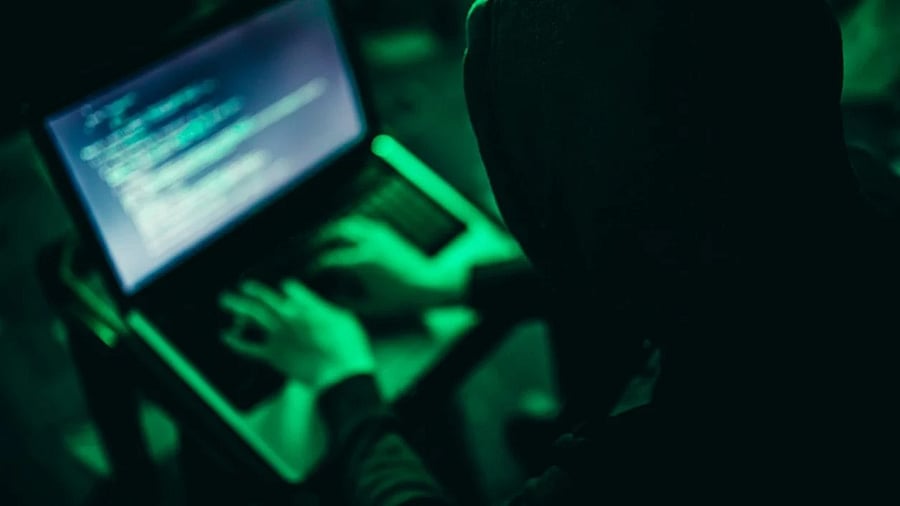
Representative image of a criminal indulging in cybercrime.
Credit: iStock Photo
In the popular Kannada film Su from So, while audiences are drawn in by its humour and everyday charm, there lies a deeper narrative. Dwelling on societal structures and their paradoxes, it also places a spotlight on the quiet emergence of strength, the kind that resides within common folk, waiting to rise. In the current landscape of cybercrime that is endemic in proportions, we need a cadre of Cyber Saathis who would be just that: everyday people who choose to stand up for others in the digital world. They are not cyber experts, but driven citizens. Like the protagonist in the film, they remind us that courage isn’t loud – it’s consistent, conscious, and compassionate. And in a world increasingly online, we need many more such everyday digital heroes.
An older OTT series Jamtara – Sabka Number Ayega offers a compelling glimpse into the growing lure of cybercrime, particularly among rural youth. It portrays how young individuals are drawn into phishing schemes, seduced not just by money but by a deeper, more dangerous illusion – a false sense of empowerment. As one character in the series chillingly states, “Yeh kaam sirf paisa kamaane ka nahi hai, power ka bhi hai.” This line encapsulates the deceptive narrative of agency and purpose that often fuels such illicit ventures.
Defining cybercrimes in particular, we are talking not about standalone crimes, but a suite of purposeful crimes such as digital arrests, cyber stalking, blackmailing, sextortion, cyber frauds and attacks perpetrated against young adults and digital pornography, crimes through online games victimising children. According to a recent statement made by the Ministry of Home Affairs (MHA) in the Rajya Sabha, the number of reported cybercrimes rose by over 401% since 2021. Many of these crimes targeted children and created undue challenges for their growth and development at a young, impressionable, but defenceless age. Between 2018 and 2022, more than 3,000 cases of dissemination of child pornography and 500 cases of cyber stalking of children were registered.
Karnataka has been reported as the state third-worst affected by cybercrime, behind Maharashtra and Uttar Pradesh. There has been a dramatic increase, by 424%, of cybercrimes in the state, from 2021 to 2024, as per statistics in the National Cybercrime Reporting Portal. Building a rapid response team that can understand and quickly respond to any cybercrime event is the need of the hour.
A Cyber Saathi model could typically focus on developing a strong ecosystem of cybercrime busters of all ages, aiding the police force. This cadre would be adept at assessing contextual issues, thereby providing a realistic assessment to cybercrime cells, but also providing the much-needed peerage support to victims, in the form of a Saathi, as the first line of credible information and defence, in the community. They can help tide over the societal impacts of these crimes, marching hand in hand with the real-time crime fighters – the cyber cells of the police forces, making sure there is more time available to fight the core issues that perpetuate them.
Awareness and outreach
Cyber Saathis can be trained to build capacity, to not only create awareness on the nature and societal impacts of cybercrimes, but also to administer ‘cyber first-aids’, leading victims through the process of formal registration of complaints and access to legal support. The model can be intensified via a Public-Private Partnership Model, with the law and policymakers providing core guidance and support for capacity-building activities, while civil society organisations, NGOs, and CSR entities could provide
the framework for disseminating structured response actions and regular cyber information literacy programmes. Schools, colleges and academic centres can adopt and institutionalise the model to provide broader coverage.
While it is not practically possible to eradicate cybercrimes in the short term, a beginning must be made in communities, resident welfare groups, and civil society organisations with linkages to wider support systems and initiatives by the State. The model can empower everyday individuals to become digital sentinels in their communities, just as Su from So reminds us that true change and empowerment often begin in the quietest corners, with someone simply choosing not to look away.
Cyber Saathis become relevant since technology can alert, but only context can interpret. They come in since they are real people who are rooted in real communities, and trained to connect the dots that machines can’t. Law enforcement is overburdened, often coming in post-facto. They can bridge the gap between awareness and action, preventing harm, not just responding to it.
(Anupama is Mission Director – Biocon Foundation CSR; Harini is an associate professor, Department of Sciences and Humanities, Manipal Institute of Technology, and Annapoorna is an independent consultant)